Hydraulic Modeling of Beaver Dams and Evaluation of Their Impacts on Flood Events
Abstract
1. Introduction
2. Methods
2.1. Survey of Beaver Territories
2.1.1. Mapping Concept and Study Sites
2.1.2. Parameter Selection and Data Acquisition
2.2. Hydraulic Modeling of Beaver Dams
2.2.1. Modeling Concept
2.2.2. Study Sites and Initial Hydraulic Models
2.2.3. Representation of Beaver Dams in HYDRO_AS-2D
2.2.4. Investigated Flood Events
2.2.5. Evaluation of Hydraulic Model Results
3. Results
3.1. Analysis and Characterization of Beaver Territories
3.1.1. Characteristics of Dam Cascades
3.1.2. Characteristics of Beaver Dams
3.2. Implementation of Dam Cascades in the Hydraulic Models
3.2.1. Scheme for the Derivation of Potential Beaver Dam Locations
3.2.2. Definition of Beaver Dam Scenarios
3.3. Impact on the Investigated Flood Events
3.3.1. Flood Peak Attenuation and Translation
3.3.2. Impact of Topographical Characteristics on the Effects of Beaver Dam Cascades
4. Discussion
4.1. Survey and Analysis of Beaver Territories
4.2. Development of Hydraulic Beaver Dam Scenarios
4.3. Model Approach
4.4. Impact of the Investigated Beaver Dam Cascades on Flood Events
5. Conclusions
Author Contributions
Funding
Acknowledgments
Conflicts of Interest
References
- Bayerisches Staatsministerium für Umwelt und Verbraucherschutz (StMUV). Hochwasserschutz: Aktionsprogramm 2020plus: Bayerns Schutzsstrategie: Ausweiten, Intensivieren, Beschleunigen; StMUV: München, Germany, 2014; 2020p. [Google Scholar]
- Bund/Länder-Arbeitsgemeinschaft Wasser (LAWA). Leitlinien für Einen Zukunftsweisenden Hochwasserschutz: Hochwasser—Ursachen und Konsequenzen; LAWA: Stuttgart, Germany, 1995. [Google Scholar]
- Bayerisches Landesamt für Umwelt. Bayerische Hochwasserschutzstrategien: Bayerisches Gewässer- Aktionsprogramm 2030; Bayerisches Landesamt für Umwelt: Augsburg, Germany, 2018. [Google Scholar]
- Nicholson, A.R.; Wilkinson, M.E.; O’Donnell, G.M.; Quinn, P.F. Runoff attenuation features: A sustainable flood mitigation strategy in the Belford catchment, UK. Area 2012, 44, 463–469. [Google Scholar] [CrossRef]
- Soulsby, C.; Dick, J.; Scheliga, B.; Tetzlaff, D. Taming the flood-How far can we go with trees? Hydrol. Process. 2017, 31, 3122–3126. [Google Scholar] [CrossRef]
- Metcalfe, P.; Beven, K.; Hankin, B.; Lamb, R. A modelling framework for evaluation of the hydrological impacts of nature-based approaches to flood risk management, with application to in-channel interventions across a 29 km2 scale catchment in the United Kingdom. Hydrol. Process. 2017, 31, 1734–1748. [Google Scholar] [CrossRef]
- Dadson, S.J.; Hall, J.W.; Murgatroyd, A.; Acreman, M.; Bates, P.; Beven, K.; Heathwaite, L.; Holden, J.; Holman, I.P.; Lane, S.N.; et al. A restatement of the natural science evidence concerning catchment-based ’natural’ flood management in the UK. Proceedings. Math. Phys. Eng. Sci. 2017, 473, 20160706. [Google Scholar] [CrossRef] [PubMed]
- The River Restoration Centre. The River Restoration Centre–Strategic Plan: 2016 to 2021; The River Restoration Centre: Cranfield, UK, 2016. [Google Scholar]
- Rosell, F.; Bozser, O.; Collen, P.; Parker, H. Ecological impact of beavers Castor fiber and Castor canadensis and their ability to modify ecosystems. Mammal Rev. 2005, 35, 248–276. [Google Scholar] [CrossRef]
- Zahner, V. Einfluß des Bibers auf Gewässernahe Wälder: Ausbreitung der Population Sowie Ansätze zur Integration des Bibers in die Forstplanung und Waldbewirtschaftung in Bayern; Universität München: München, Germany, 1997. [Google Scholar]
- Heidecke, D.; Klenner-Fringes, B. Studie über die Habitatnutzung des Bibers in der Kulturlandschaft und Anthropogene Konfliktbereiche; Universitätsverlag Martin-Luther-Universität Halle-Wittenberg: Halle (Saale), Germany, 1992. [Google Scholar]
- Barkham, P. Dam It! How Beavers Could Save Britain from Flooding; The Guardian: London, UK, 2017. [Google Scholar]
- Müller-Schwarze, D.; Sun, L. The Beaver: Natural History of a Wetlands Engineer, 1st ed.; Cornell University Press: Ithaca, NY, USA, 2003. [Google Scholar]
- Hartman, G. Habitat selection by European beaver (Castor fiber) colonizing a boreal landscape. J. Zool. 1996, 240, 317–325. [Google Scholar] [CrossRef]
- Gorshkov, Y.A.; Easter-Pilcher, A.L.; Pilcher, B.K.; Gorshkov, D. Ecological Restoration by Harnessing the Work of Beavers. In Beaver Protection, Management, and Utilization in Europe and North America; Busher, P.E., Dzięciołowski, R.M., Eds.; Springer US and Imprint and Springer: Boston, MA, USA, 1999; pp. 67–76. [Google Scholar]
- Hartman, G.; Törnlöv, S. Influence of watercourse depth and width on dam-building behaviour by Eurasian beaver (Castor fiber). J. Zool. 2006, 268, 127–131. [Google Scholar] [CrossRef]
- Pollock, M.M.; Lewallen, G.M.; Woodruff, K.; Jordan, C.E.; Castro, J.M. (Eds.) The Beaver Restoration Guidebook: Working with Beaver to Restore Streams, Wetlands, and Floodplains; Version 2.01; United States Fish and Wildlife Service: Portland, ON, USA, 2018. [Google Scholar]
- Swinnen, K.R.R.; Rutten, A.; Nyssen, J.; Leirs, H. Environmental factors influencing beaver dam locations. J. Wildl. Manag. 2019, 83, 356–364. [Google Scholar] [CrossRef]
- Stout, T.L. Development and Application of Hydraulic and Hydrogeologic Models to Better Inform Management Decisions. Master’s Thesis, Utah State University, Logan, UT, USA, 2017. [Google Scholar]
- Puttock, A.; Graham, H.A.; Cunliffe, A.M.; Elliott, M.; Brazier, R.E. Eurasian beaver activity increases water storage, attenuates flow and mitigates diffuse pollution from intensively-managed grasslands. Sci. Total Environ. 2017, 576, 430–443. [Google Scholar] [CrossRef]
- Puttock, A.; Graham, H.A.; Carless, D.; Brazier, R.E. Sediment and nutrient storage in a beaver engineered wetland. Earth Surf. Process. Landf. 2018, 43, 2358–2370. [Google Scholar] [CrossRef]
- Nyssen, J.; Pontzeele, J.; Billi, P. Effect of beaver dams on the hydrology of small mountain streams: Example from the Chevral in the Ourthe Orientale basin, Ardennes, Belgium. J. Hydrol. 2011, 402, 92–102. [Google Scholar] [CrossRef]
- Dalbeck, L.; Janssen, J.; Luise Völsgen, S. Beavers (Castor fiber) increase habitat availability, heterogeneity and connectivity for common frogs (Rana temporaria). Amphibia-Reptilia 2014, 35, 321–329. [Google Scholar] [CrossRef]
- Westbrook, C.J.; Cooper, D.J.; Baker, B.W. Beaver dams and overbank floods influence groundwater-surface water interactions of a Rocky Mountain riparian area. Water Resour. Res. 2006, 42, 288. [Google Scholar] [CrossRef]
- Yörük, A. Unsicherheiten bei der Hydrodynamischen Modellierung von Überschwemmungsgebieten; Mitteilungen/Universität der Bundeswehr München, Institut für Wasserwesen, Siedlungswasserwirtschaft und Abfalltechnik; Shaker: Aachen, Germany, 2009; Volume 99. [Google Scholar]
- Kreiter, T. Dezentrale und Naturnahe Retentionsmaßnahmen als Beitrag zum Hochwasserschutz in Mesoskaligen Einzugsgebieten der Mittelgebirge. Ph.D. Thesis, Universität Trier, Trier, Germany, 2007. [Google Scholar]
- Rieger, W. Prozessorientierte Modellierung dezentraler Hochwasserschutzmaßnahmen; Universität der Bundeswehr: Neubiberg, Germany, 2012. [Google Scholar]
- Teschemacher, S.; Rieger, W. Ereignisabhängige Optimierung dezentraler Kleinrückhaltebecken unter Berücksichtigung von Standort, Retentionsvolumen und Drosselweite. Hydrologie und Wasserbewirtschaftung 2018, 62, 321–335. [Google Scholar]
- Ascending Technologies GmbH. AscTec Falcon 8 + AscTec Trinity—Sicherheitsdatenblatt; Ascending Technologies GmbH: Krailling, Germany, 2015. [Google Scholar]
- Sony Corporation. Digitalkamera mit Wechselobjektiv—Handbuch; Sony Corporation: Tokyo, Japan, 2011. [Google Scholar]
- Willems, W.; Stricker, K.; Ansarian, C. Flächendetaillierte Ermittlung der Hochwasserquantile für Bayern: Nachführung; Bayerisches Landesamt für Umwelt: Augsburg, Germany, 2017. [Google Scholar]
- Woo, M.K.; Waddington, J.M. Effects of Beaver Dams on Subarctic Wetland Hydrology. Arctic 1990, 43, 223–230. [Google Scholar] [CrossRef]
- Hydrotec Ingenieurgesellschaft für Wasser und Umwelt mbH; Nujic, M. Benutzerhandbuch HYDRO_AS-2D: 2D-Strömungsmodell für die Wasserwirtschaftliche Praxis; Hydrotec Ingenieurgesellschaft für Wasser und Umwelt mbH: Aachen, Germany, 2018. [Google Scholar]
- Schulla, J. Model Description: WaSiM: (Water Balance Simulation Model); Schulla: Zürich, Switzerland, 2015. [Google Scholar]
- Moriasi, D.N.; Arnold, J.G.; Van Liew, M.W.; Bingner, R.L.; Harmel, R.D.; Veith, T.L. Model Evaluation Guidelines for Systematic Quantification of Accuracy in Watershed Simulations. Am. Soc. Agric. Biol. Eng. 2007, 50, 885–900. [Google Scholar]
- Te Chow, V. Open-Channel Hydraulics; McGraw-Hill Civil Engineering Series; McGraw-Hill Book Company: New York, NY, USA, 1959. [Google Scholar]
- PAN Planungsbüro für Angewandten Naturschutz GmbH. Entwicklung und Anwendung Einer Methodik zur Analyse der Innerhalb der Auenkulisse Wirkenden Restriktionen (Restriktionsanalyse); PAN Planungsbüro für Angewandten Naturschutz GmbH: München, Germany, 2016. [Google Scholar]
- Rieger, W.; Teschemacher, S.; Haas, S.; Springer, J.; Disse, M. Multikriterielle Wirksamkeitsanalysen zum dezentralen Hochwasserschutz. WasserWirtschaft 2017, 107, 56–60. [Google Scholar] [CrossRef]
- Reinhardt, C.; Bölscher, J.; Schulte, A.; Wenzel, R. Decentralised water retention along the river channels in a mesoscale catchment in south-eastern Germany. Phys. Chem. Earth, Parts A/B/C 2011, 36, 309–318. [Google Scholar] [CrossRef]
- Röttcher, K.; Anders, C.; Franke, H.; Honecker, U.; Kirchhoffer, E.; Riedel, G.; Weiß, A. Abschätzung der Retentionsfähigkeit von Gewässernetzen im Hinblick auf einen Beitrag zur Hochwasserminderung. Hydrol. Und Wasserbewirtsch. 2008, 52, 179–186. [Google Scholar]
- Teschemacher, S.; Neumayer, M.; Disse, M.; Rieger, W. Retentionspotenzial von Aufforstungsmaßnahmen in einem voralpinen Einzugsgebiet. LWF Wissen 2017, 82, 11–18. [Google Scholar]
- Bauer, C. Bestimmung der Retentionspotenziale Naturnaher Maßnahmen in Gewässer und Aue mit Hydraulischen Methoden; Kasseler Wasserbau-Mitteilungen; Herkules Verl.: Kassel, Germany, 2004; Volume 16. [Google Scholar]
- Harthun, M. Biber als Landschaftsgestalter: Einfluß des Bibers (Castor fiber albicus Matschie, 1907) auf die Lebensgemeinschaft von Mittelgebirgsbächen; Maecenata-Verlag: Munich, Germany, 1998. [Google Scholar]
- Danilov, P.I.; Fyodorov, F.V. Comparative characterization of the building activity of Canadian and European beavers in northern European Russia. Russ. J. Ecol. 2015, 46, 272–278. [Google Scholar] [CrossRef]
- Müller, G. Ingenieurtechnische Aspekte der Biberdämme. KW Korresp. Wasserwirtsch. 2014, 7, 158–163. [Google Scholar]
- Gurnell, A.M. The hydrogeomorphological effects of beaver dam-building activity. Prog. Phys. Geogr. Earth Environ. 1998, 22, 167–189. [Google Scholar] [CrossRef]
- Butler, D.R.; Malanson, G.P. Sedimentation rates and patterns in beaver ponds in a mountain environment. Geomorphology 1995, 13, 255–269. [Google Scholar] [CrossRef]
- Schwaller, G.; Tölle, U. Einfluss von Maßnahmen der Gewässerentwicklung auf den Hochwasserabfluss; Bayerisches Landesamt für Wasserwirtschaft: Munich, Germany, 2005. [Google Scholar]
- Neumayer, M.; Heinrich, R.; Rieger, W.; Disse, M. Vergleich Unterschiedlicher Methoden zur Modellierung von Renaturierungs- und Auengestaltungsmaßnahmen mit Zweidimensionalen Hydrodynamisch-Numerischen Modellen. In M3—Messen, Modellieren, Managen in Hydrologie und Wasserressourcenbewirtschaftung; Forum für Hydrologie und Wasserbewirtschaftung; Schütze, N., Müller, U., Schwarze, R., Wöhling, T., Grundmann, J., Eds.; Fachgemeinschaft Hydrologische Wissenschaften in der DWA Geschäftsstelle: Hennef, Germany, 2018; Volume 39, pp. 147–156. [Google Scholar]
- Nujic, M. Praktischer Einsatz Eines Hochgenauen Verfahrens für die Berechnung von Tiefengemittelten Strömungen; Mitteilungen des Instituts für Wasserwesen der Universität der Bundeswehr München: Munich, Germany, 1998; Volume 62. [Google Scholar]
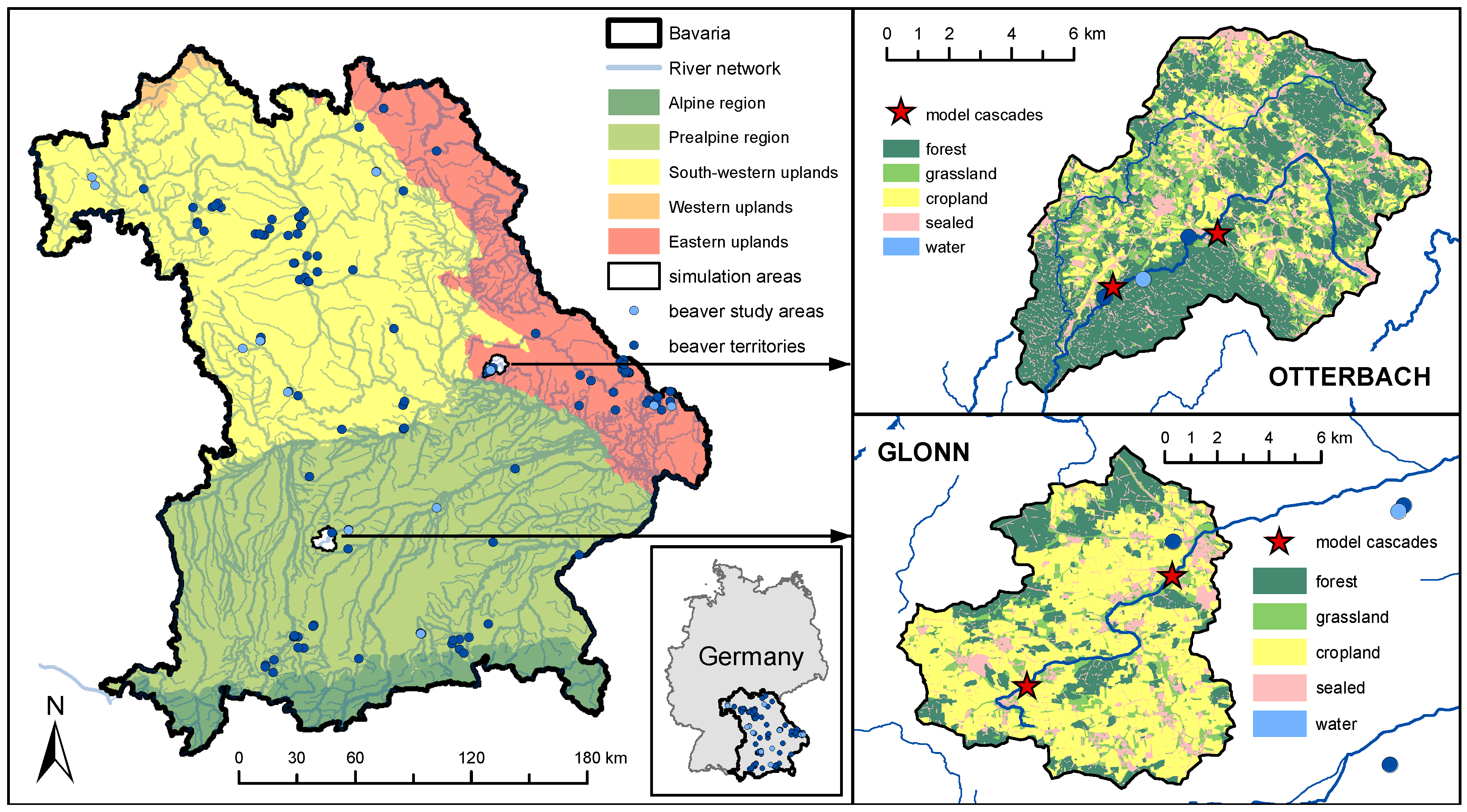
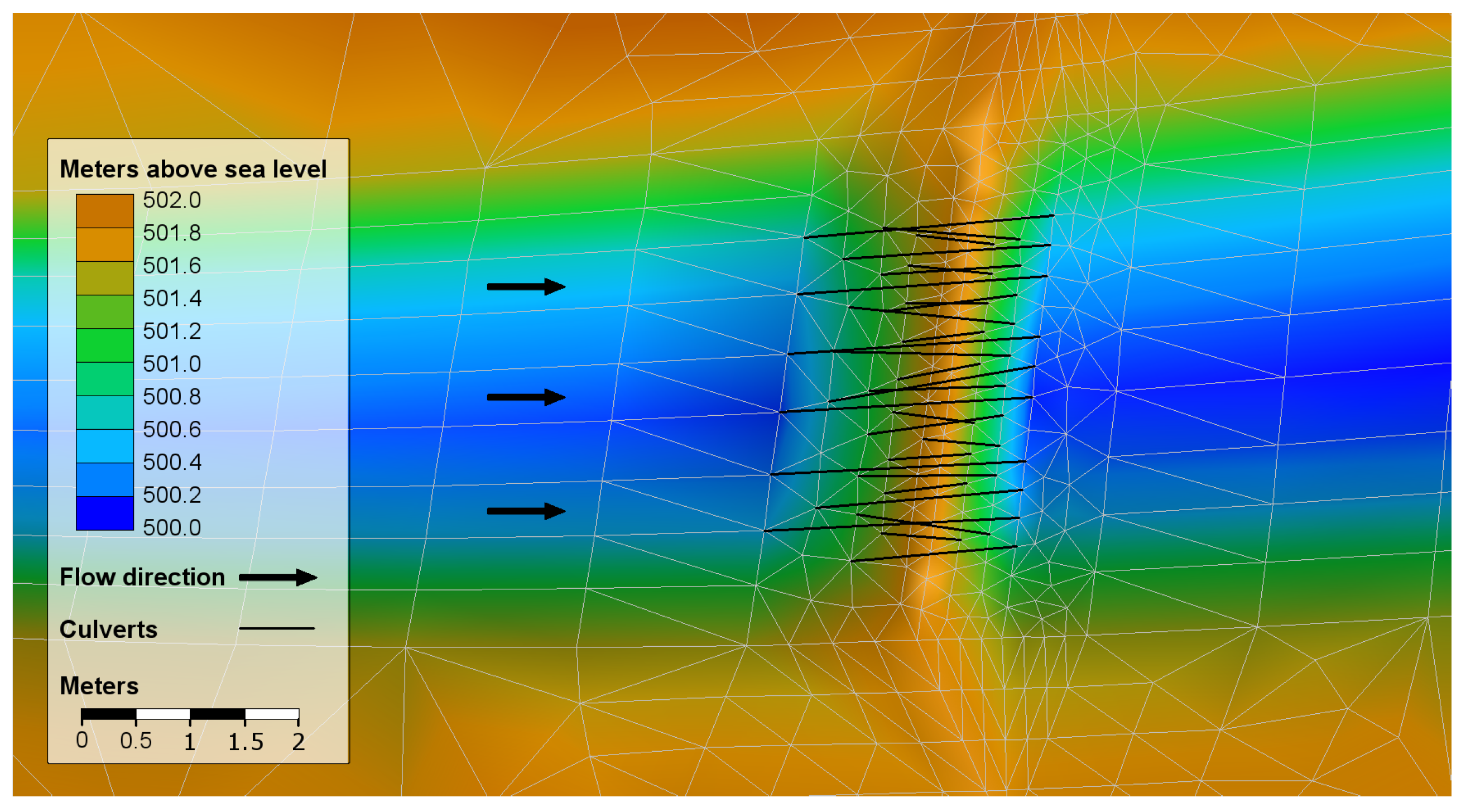
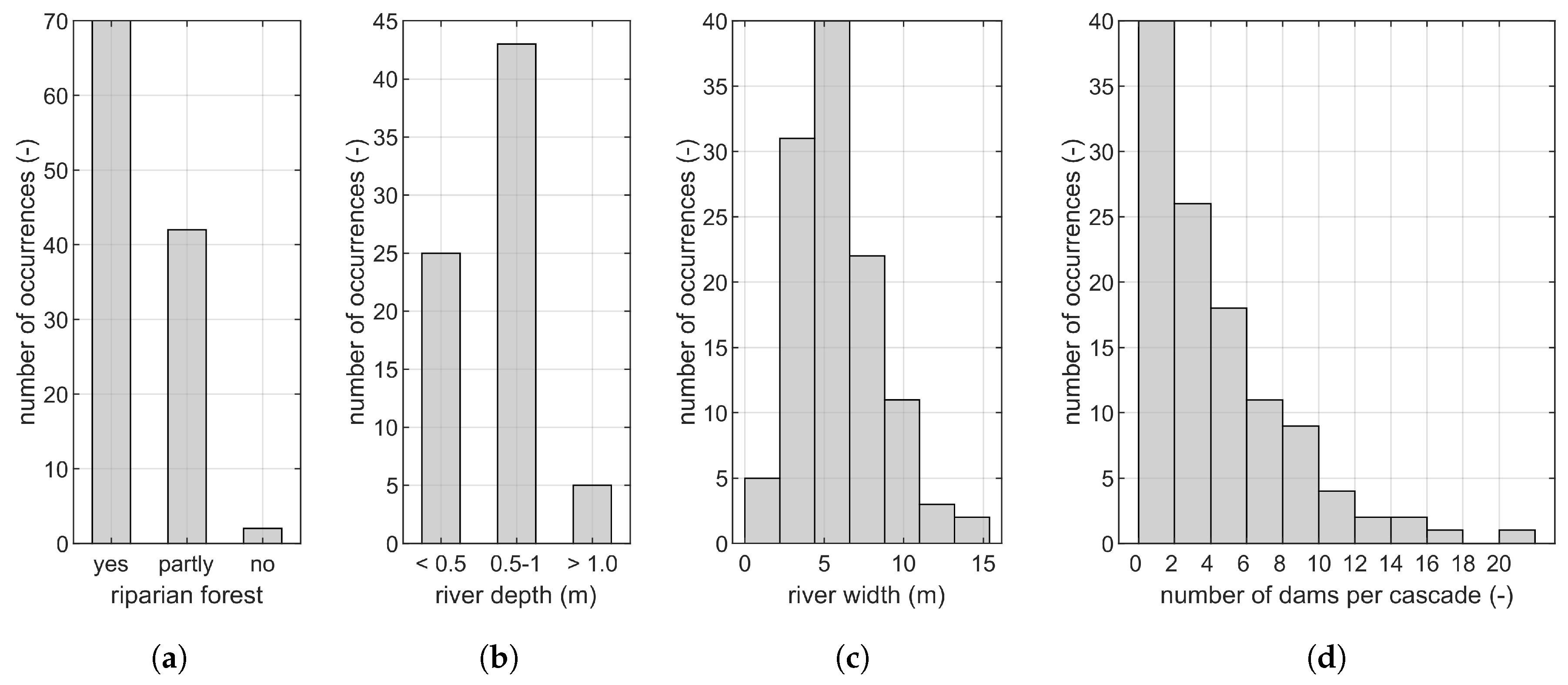
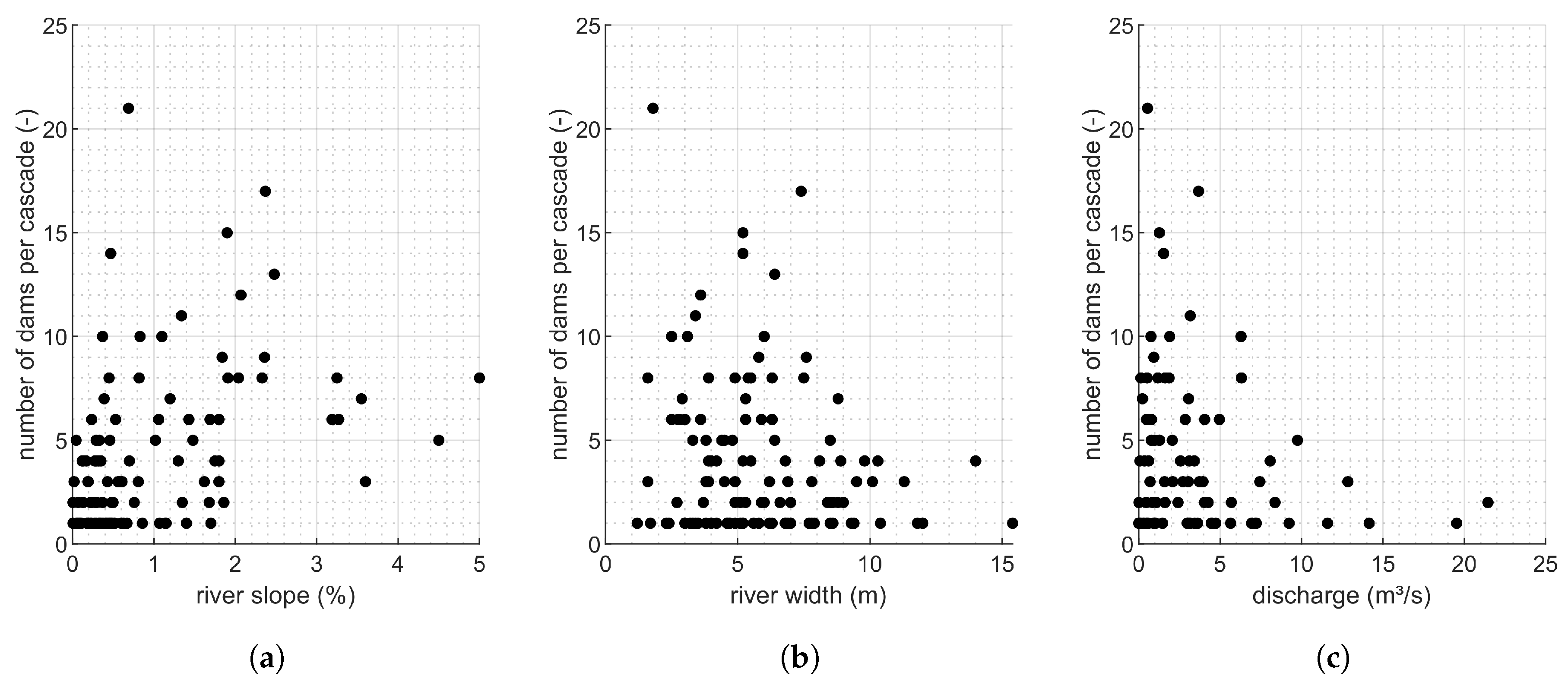
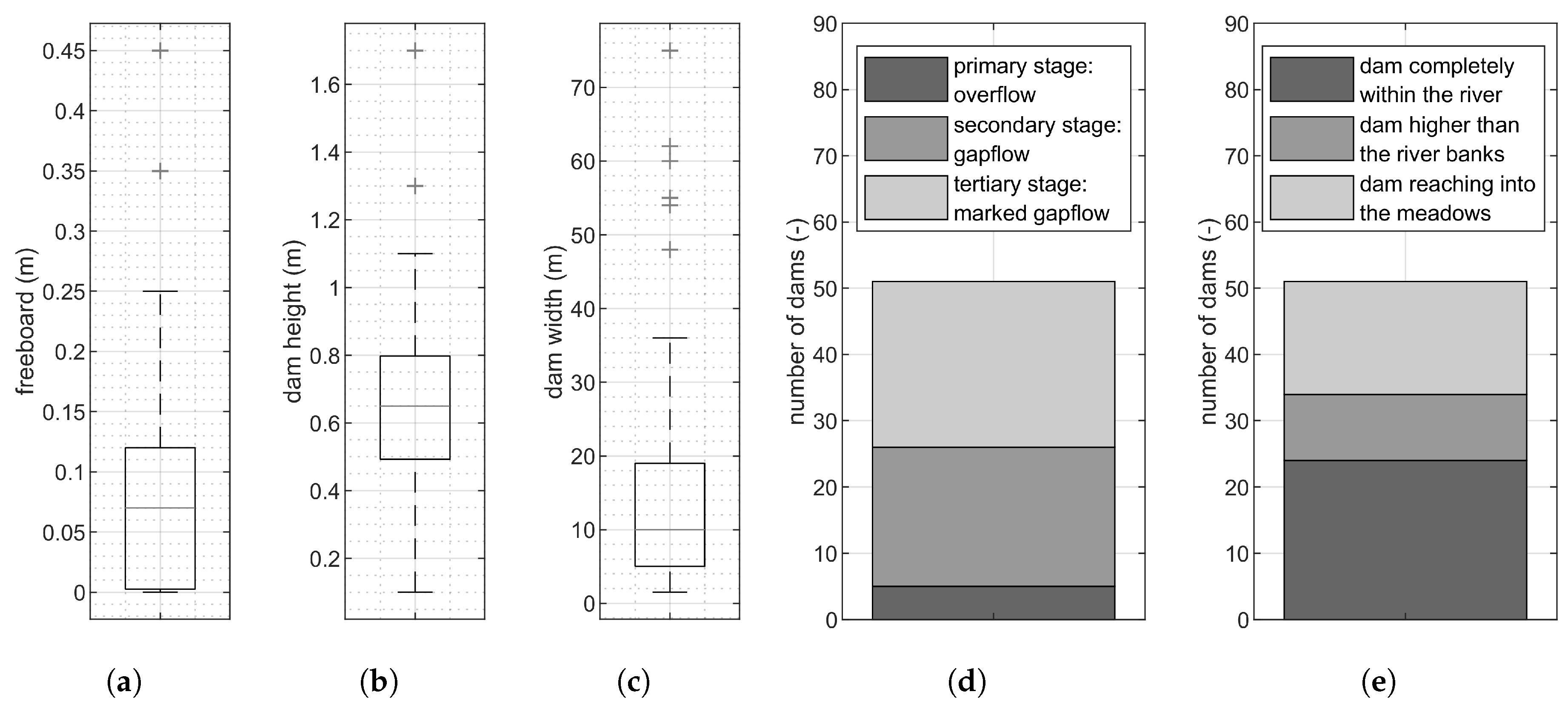
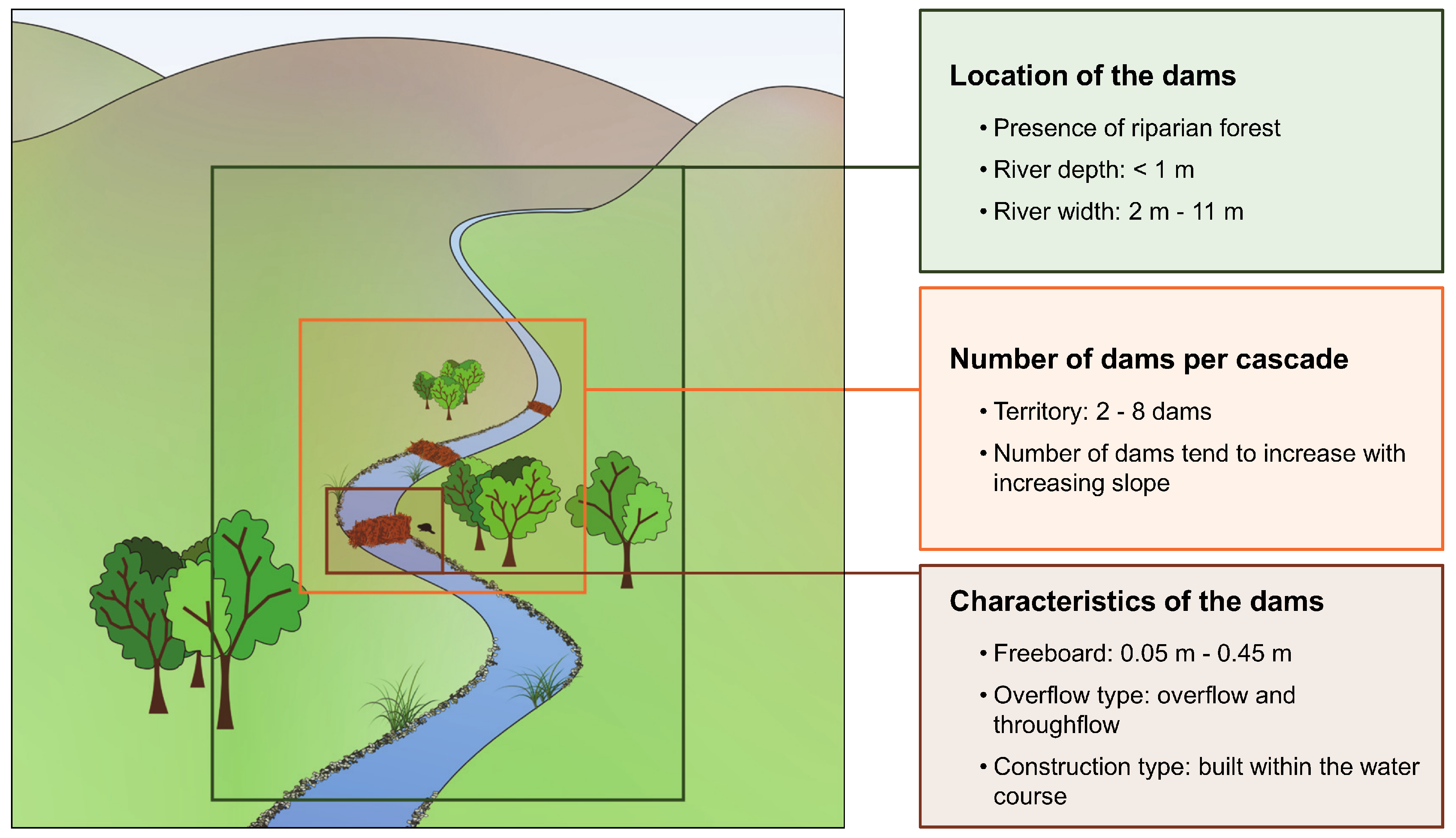
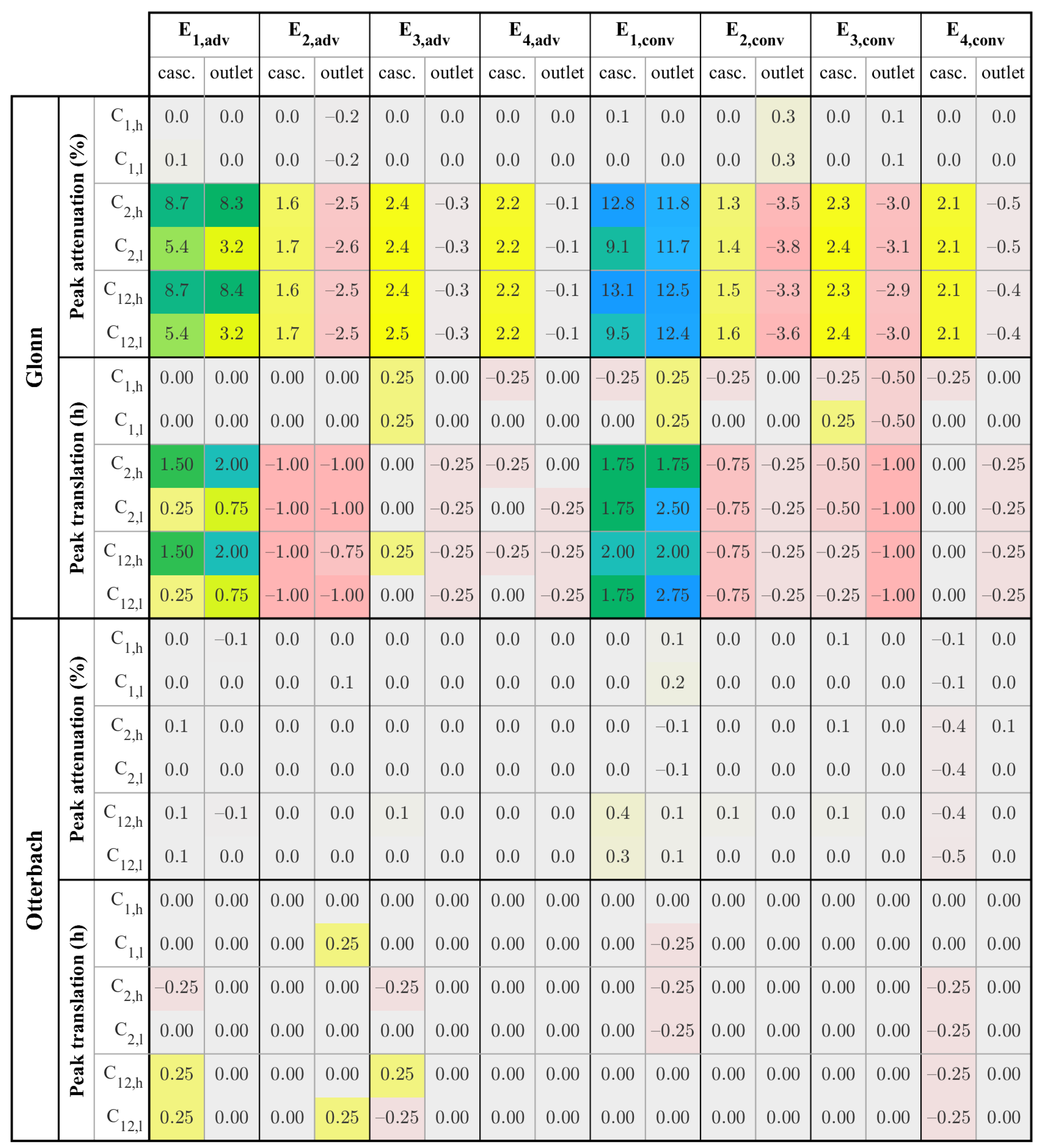
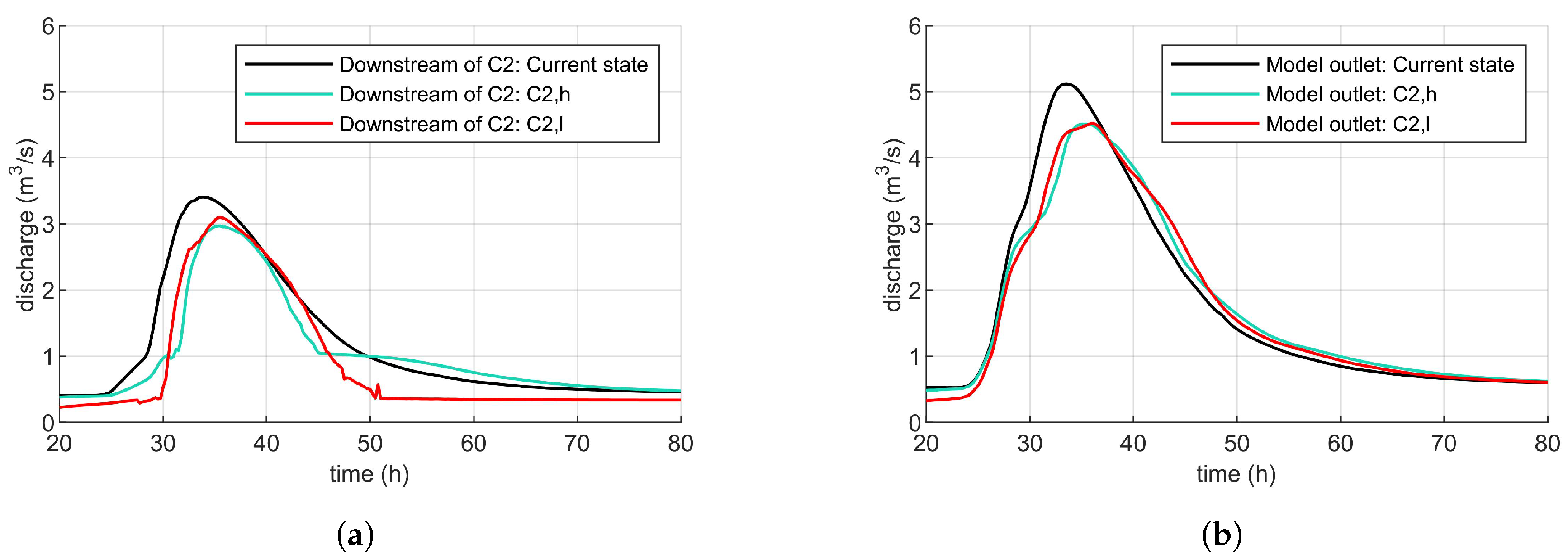
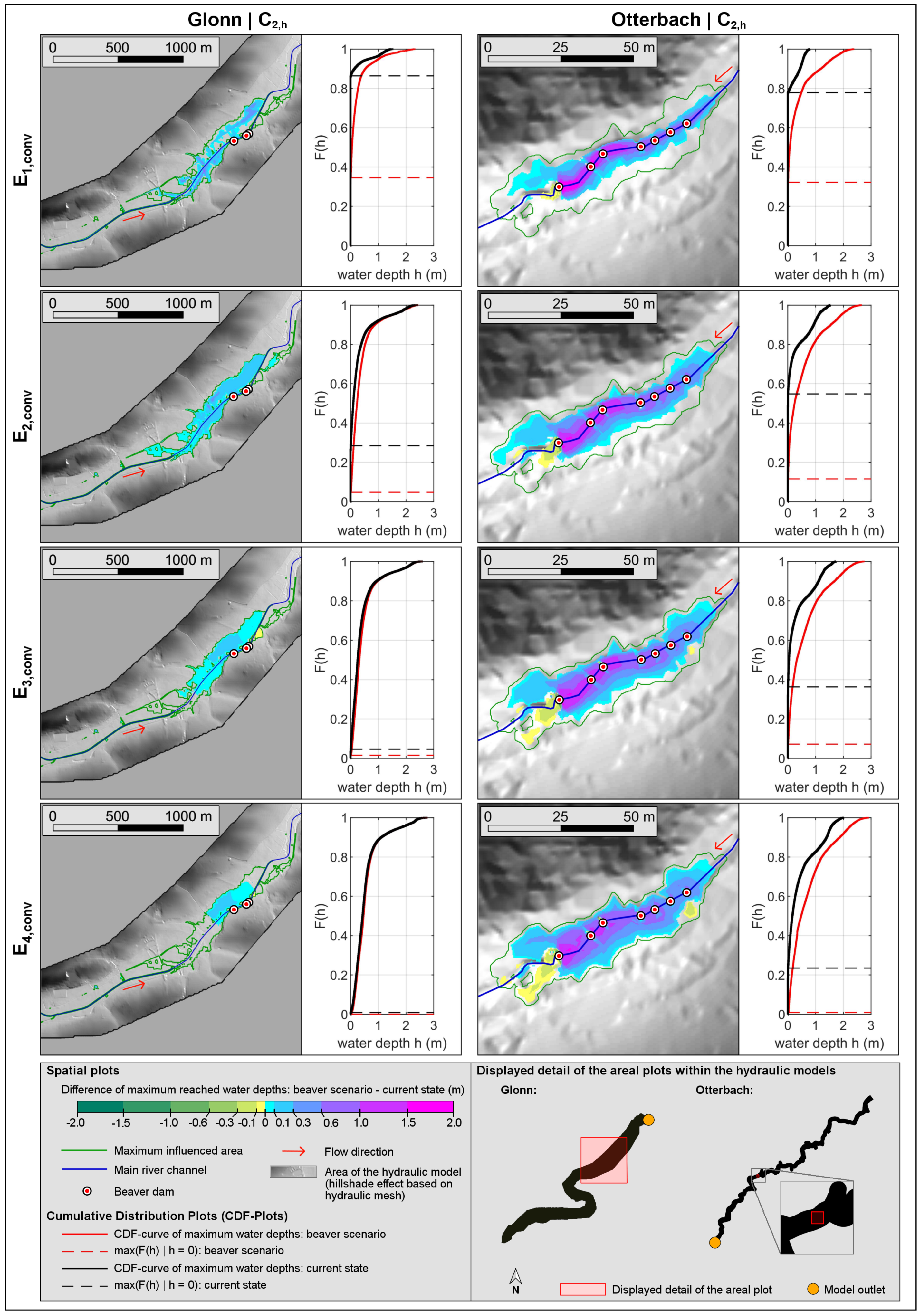
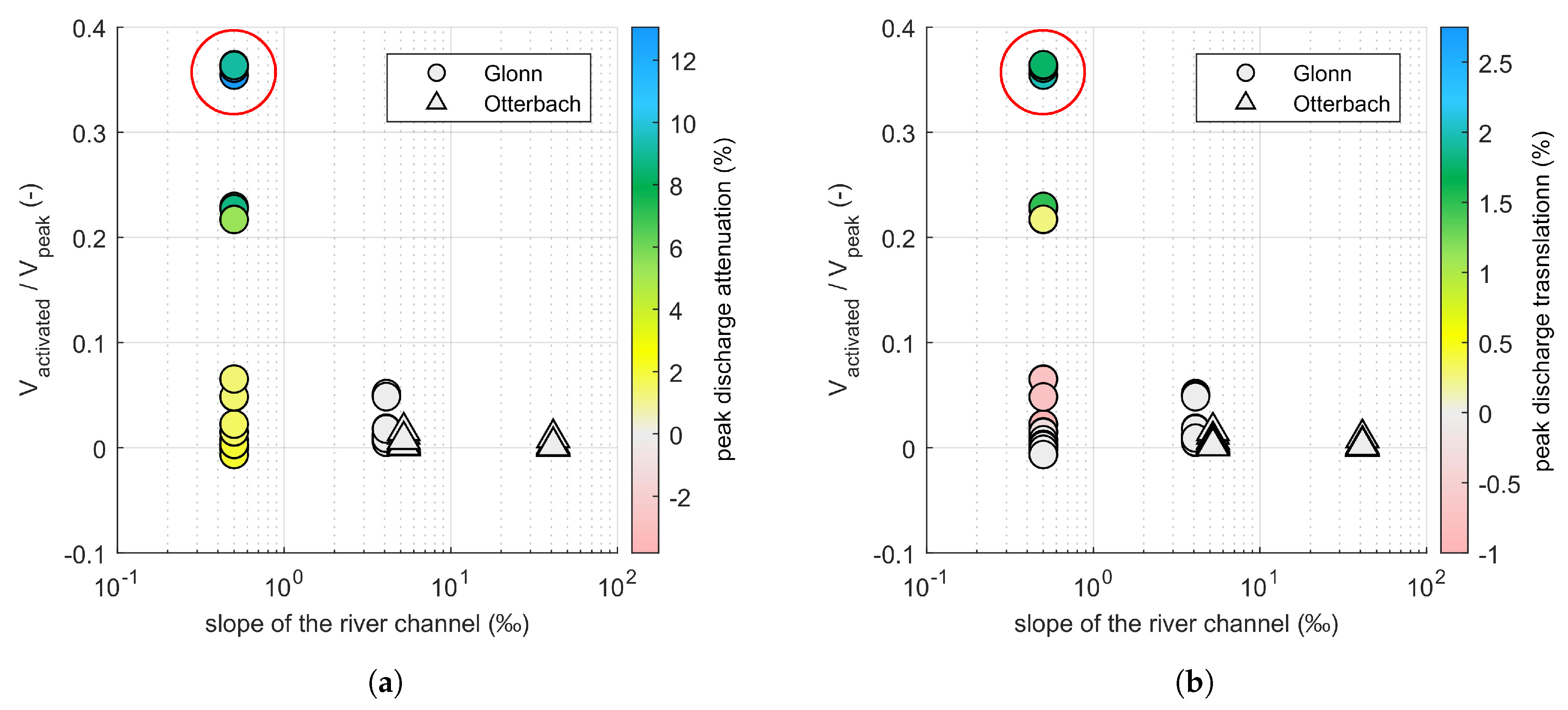
| GLONN | OTTERBACH | |||
|---|---|---|---|---|
| Parameter (Unit) | Catchment | Hydraulic Model | Catchment | Hydraulic Model |
| size (km) | 104 | 8.7 | 91 | 3.5 |
| slope (%) | 4.6 | 0.1 | 8.5 | 1.0 |
| river length (m) | 21 | 13.6 | 24 | 15.6 |
| river slope (‰) | 1.6 | 1.5 | 8.7 | 6–15.5 |
| valley type | no specific valley type | V- and U-shaped valley | ||
| region | tertiary molasse hills | granite region | ||
| forest share (%) | 24.0 | 7.8 | 47.3 | 8.3 |
| grassland share (%) | 11.4 | 71.6 | 18.6 | 64.3 |
| cropland share (%) | 53.4 | 13.1 | 24.7 | 11.7 |
| sealed share (%) | 10.8 | 1.3 | 8.8 | 2.1 |
| water share (%) | 0.4 | 6.2 | 0.6 | 13.6 |
| FLOOD EVENT | GLONN | OTTERBACH | |||||||||||
|---|---|---|---|---|---|---|---|---|---|---|---|---|---|
| Discharge | Precipitation | Discharge | Precipitation | ||||||||||
| Name | Return Period | Peak Q(m/s) | Volume (mm) | Duration (h) | Max I (mm/h) | Volume (mm) | Duration (h) | Peak Q (m/s) | Volume (mm) | Duration (h) | Max I (mm/h) | Volume (mm) | Duration (h) |
| E | 5 × MD | 4.6 | 1.6 | 21.50 | 3.7 | 31.50 | 18.00 | 4.1 | 2.6 | 32.25 | 3.3 | 38.1 | 29.00 |
| E | 4.7 | 1.0 | 12.00 | 15.3 | 21.50 | 3.00 | 3.7 | 0.7 | 8.75 | 19.2 | 22.9 | 3.00 | |
| E | 2 years | 13.4 | 7.5 | 40.25 | 4.0 | 62.20 | 35.00 | 13.1 | 4.4 | 37.50 | 3.7 | 61.9 | 43.00 |
| E | 14.2 | 4.1 | 14.50 | 23.1 | 32.60 | 3.00 | 11.9 | 2.2 | 8.25 | 26.2 | 31.0 | 3.00 | |
| E | 5 years | 18.1 | 10.2 | 45.00 | 4.1 | 72.40 | 41.00 | 18.2 | 6.6 | 42.00 | 3.9 | 76.7 | 51.00 |
| E | 19.0 | 6.1 | 16.00 | 29.2 | 41.90 | 4.00 | 16.8 | 3.4 | 8.50 | 29.2 | 34.6 | 3.00 | |
| E | 20 years | 28.1 | 14.8 | 50.25 | 4.3 | 93.30 | 51.00 | 26.4 | 12.7 | 51.75 | 4.3 | 96.7 | 63.00 |
| E | 31.4 | 8.8 | 16.25 | 41.0 | 51.00 | 4.00 | 24.7 | 4.9 | 8.00 | 34.0 | 40.3 | 3.00 | |
| Investigation Area | Cascade | Number of Dams | Distances Between Dams (M) | River Width (M) | Ø Slope of the River Section (‰) | Catchment Size at Cascade Location (km) |
|---|---|---|---|---|---|---|
| Glonn | C | 4 | 42-22-31 | 7 | 4.1‰ | 18.2 |
| C | 3 | 114-33 | 11 | 0.5‰ | 75.2 | |
| Otterbach | C | 4 | 17-21-46 | 5 | 5.2‰ | 25.8 |
| C | 7 | 9-16-12-14-9-9 | 6 | 41.1‰ | 44.3 |
| FLOOD EVENT | GLONN | OTTERBACH | ||||||||||
|---|---|---|---|---|---|---|---|---|---|---|---|---|
| C | C | C | C | |||||||||
| (m/s) | (m) | (h) | (m/s) | (m) | (h) | (m/s) | (m) | (h) | (m/s) | (m) | (h) | |
| E | 1.1 | 32,030 | 18.50 | 3.8 | 121,467 | 21.00 | 1.4 | 59,193 | 25.50 | 2.0 | 87,858 | 26.25 |
| E | 1.9 | 34,150 | 9.25 | 3.4 | 63 426 | 11.75 | 2.4 | 30,144 | 6.50 | 3.1 | 41,587 | 7.25 |
| E | 3.8 | 166,952 | 35.25 | 11.8 | 566,257 | 38.50 | 4.2 | 126 700 | 34.75 | 8.0 | 223,549 | 35.75 |
| E | 5.5 | 100,837 | 9.75 | 10.0 | 298,053 | 15.00 | 6.5 | 72,626 | 5.25 | 9.5 | 115,210 | 5.75 |
| E | 5.1 | 211,428 | 38.50 | 15.5 | 787,742 | 43.50 | 6.1 | 203,027 | 40.25 | 11.2 | 330,482 | 40.00 |
| E | 7.4 | 138,944 | 10.25 | 14.0 | 423,990 | 16.00 | 8.9 | 105,401 | 5.50 | 12.4 | 129,826 | 5.00 |
| E | 7.5 | 320,379 | 44.25 | 23.3 | 1,139,651 | 49.00 | 8.9 | 343,951 | 48.75 | 15.2 | 582,287 | 48.50 |
| E | 10.9 | 188,349 | 10.25 | 23.3 | 560,151 | 15.25 | 13.1 | 140,319 | 5.25 | 17.9 | 257,739 | 6.00 |
© 2020 by the authors. Licensee MDPI, Basel, Switzerland. This article is an open access article distributed under the terms and conditions of the Creative Commons Attribution (CC BY) license (http://creativecommons.org/licenses/by/4.0/).
Share and Cite
Neumayer, M.; Teschemacher, S.; Schloemer, S.; Zahner, V.; Rieger, W. Hydraulic Modeling of Beaver Dams and Evaluation of Their Impacts on Flood Events. Water 2020, 12, 300. https://doi.org/10.3390/w12010300
Neumayer M, Teschemacher S, Schloemer S, Zahner V, Rieger W. Hydraulic Modeling of Beaver Dams and Evaluation of Their Impacts on Flood Events. Water. 2020; 12(1):300. https://doi.org/10.3390/w12010300
Chicago/Turabian StyleNeumayer, Michael, Sonja Teschemacher, Sara Schloemer, Volker Zahner, and Wolfgang Rieger. 2020. "Hydraulic Modeling of Beaver Dams and Evaluation of Their Impacts on Flood Events" Water 12, no. 1: 300. https://doi.org/10.3390/w12010300
APA StyleNeumayer, M., Teschemacher, S., Schloemer, S., Zahner, V., & Rieger, W. (2020). Hydraulic Modeling of Beaver Dams and Evaluation of Their Impacts on Flood Events. Water, 12(1), 300. https://doi.org/10.3390/w12010300





